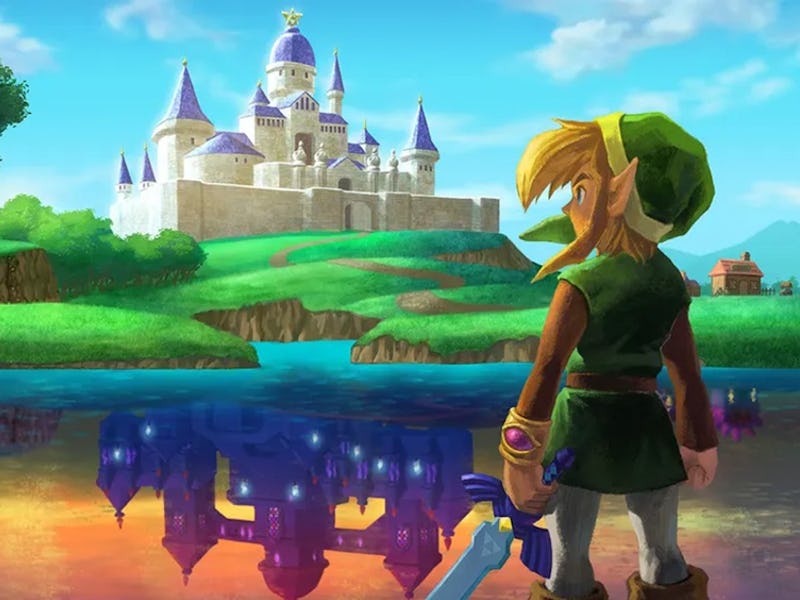9 years later, the most underrated Zelda game still holds up
The precursor to Breath of the Wild.

There are few franchises as storied and prolific as The Legend of Zelda, and that kind of legacy tends to breed a sense of complacency in video games. In other words, popular game series tend to lack innovation. It’s the whole “don’t fix something that ain’t broken” mantra. While Breath of the Wild gets most of the credit for redefining the Zelda formula, it actually owes a lot to another entry that was released four years earlier and doesn’t nearly get the credit it deserves. The Legend of Zelda: A Link Between Worlds not only functions as a sequel to one of the greatest adventure games ever, but it also crucially re-examines what makes Zelda games tick.
A Link Between Worlds was released on Nintendo 3DS in November 2013, and the story takes place in the same version of Hyrule as A Link to the Past but many years later. At first glance, it seems like a much simpler Zelda story, with Link as the apprentice of a blacksmith. After traveling to Hyrule Castle with a delivery, Link runs into a sorcerer named Yuga, who transforms him into a 2D painting, introducing the main gimmick of the game.
A Link Between World’s unique 2D -Link gimmick makes great use of the 3D features of Nintendo’s handheld.
After that first encounter with Yuga, however, A Link Between Worlds really starts to show its unique qualities. A mysterious merchant named Ravio helps Link transform back into his 3D self, and opens up a shop where you can “rent” all of the different equipment Link uses, like the Hookshot, Fire Rod, etc.
At this moment the game blows wide open with the realization you can tackle dungeons in any order you want to. Yes, there’s technically a “correct” order, but this was the very first Zelda game that actually gave players complete freedom in how they tackled dungeons and objectives. In a way, this foreshadows the absolutely freedom provided by Breath of the Wild, but A Link Between Worlds layers in another brilliant system by having you rent items.
If you are defeated in a dungeon, you’ll return to Ravio’s shop and have to return your rented time, meaning you’ll have to pay the requisite number of Rupees to get it once again. This creates a fascinating risk-reward system that other Zelda games simply don’t have. Rupees are suddenly incredibly valuable to the core experience, not just buying consumable items. Now you need to judge the order you want to get equipment, as you won’t have enough Rupees to get everything at once.
A Link Between Worlds has fantastic dungeon design that lets you tackle things in any order, with various pieces of equipment.
That level of freedom integrally changes how you approach the Zelda formula, and it makes each player’s journey through the game more personalized, which again is something Breath of the Wild would take even further.
While the gameplay innovations of A Link Between Worlds are enough to stand on their own, the game also needs to be commended for the brilliant take it provides on Zelda’s narrative structure. Like A Link to the Past, this game has you traveling between the Light World and the Dark World, and initially, the story seems like it’s another typical case of Ganon looking to destroy the world.
Eventually, Link meets Hilda, the Dark World counterpart of Princess Zelda, and while Hilda helps in your quest the tail-end of the game reveals a shocking secret. The Dark World was once a realm just like Hyrule, but a desire for the power of the Triforce led the world into ruin. At that point, it was decided the Triforce would be completely destroyed to save the realm, which only ended up driving it further into ruin. Driven to the brink of despair Hilda hatched a plan with Yuga, controlling Ganon to infiltrate the realm of Hyrule and steal their Triforce.
One of the biggest successes of A Link Between Worlds is how it brings new context to both Link and Zelda’s characters.
From there it’s then revealed Ravio is actually the Dark Word’s version of Link, a fallen hero that can’t bring himself to save his own realm, and has to recruit his Light World counterpart to do the job for him. This singular twist brings a fascinating new element to the mythos of both Link and Zelda painting them as not mythical heroes, but fragile humans that can just as easily fall to weakness and evil when driven into a corner. Ravio is a boisterous and quirky character, but his real brilliance is in providing our first fully-voiced Link, without players even knowing it.
A Link Between Worlds is easily one of the more accessible Zelda games for newcomers, but that lies wholly in how it redefines the formula of the series at large, both narratively and mechanically. That realization doesn’t set in until you play through the entire experience, which could be why the game doesn’t seem to have the same legacy as other entries. Nine years later, however, it’s easier to see just how groundbreaking A Link Between Worlds really was, and it’s one of those rare titles that seems to only get better with age.
This article was originally published on